












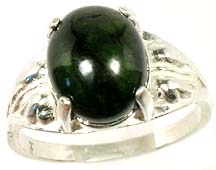
Antique Eighteenth Century Genuine Natural Russian Four and Three-Quarter Carat (Plus) Regally Colored Oval Cut Dark Green Tourmaline. Contemporary High Quality Sterling Silver Ring (Size 7 – Resizing Available).
NOTE: Resizing is available. 14kt solid gold setting is also available.
CLASSIFICATION: Tourmaline Oval Cabochon.
ORIGIN: The Ural Mountains, Russia. 18th Century.
SIZE: Length: 11mm. Width: 9mm. Depth: 4 1/2mm. All measurements approximate.
WEIGHT: 4.81 carats.
NOTE: Resizing is available. If you would prefer a different setting style, odds are we have many different setting styles available which would fit this stone(s) which could be substituted for no or very little additional cost. 14kt solid gold settings are also available. Write us for pictures and prices.
NOTE: If you would like only the gemstone, and not the setting, we can dismount the gemstone and offer you the gemstone without the setting. Just let us know, and yes, we’ll discount the price by the cost of the setting.
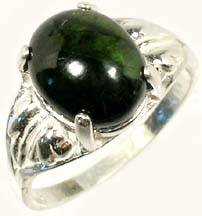
DETAIL: In Renaissance Europe up until the sixteenth or seventeenth century, red and pink tourmaline was thought to be ruby. Only a century later green or "chrome" tourmaline misidentified as “Brazilian emerald” bedazzled seventeenth century Europe. In the eighteenth century, it was eventually realized that the "Brazilian emeralds" were not emeralds at all, they were tourmaline. Consequentially, for example, many stones in the Russian Crown jewels (housed in the Kremlin) from the 17th century once thought to be rubies and emeralds are actually tourmalines. Tourmaline occurs in more colors and combinations of colors than any other gemstone variety. In fact an ancient legend says that tourmaline is found in all colors because it traveled along a rainbow and gathered all the rainbow's colors. But in the ancient past, it has led to tourmaline being confused with other colored gemstones. For instance archaeological and historical evidence indicates that tourmaline was most likely known by the ancient Romans, but called other names such as emerald or topaz.
You’ll likely never, ever see a gemstone as unique as this. A very large richly colored and textured tourmaline gemstone from Siberia, the Ural Mountains of Russia. Very handsome and quite exceptional in character, this striking gemstone was hand shaped and polished into this very beautiful oval cut cabochon by an 18th century Russian artisan. This lustrous semi-precious gemstone possesses a regal and colorful character. It is a nice quality tourmaline by 18th century standards. The gemstone would be more or less transparent except for the fact that it is so thick. Given the thick cut, it is more translucent to opaque than transparent. To casual observation if seems simply a very large, beautiful, extraordinary, brightly colored tourmaline. But of course very close scrutiny, especially under high magnification, will reveal lots of sins. There’s even a small surface blemish as you can see. It is caused by a sparkly seam of colorless crystalline material which comes right to the surface of the gemstone, and so terminates in a surface blemish which can be seen and felt (with a fingernail).
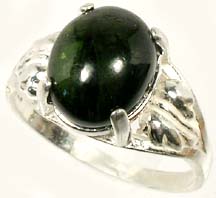
Keep in mind however that these images here are photo enlargements and so every little blemish is going to appear absolutely huge. In hand to the casual view these blemishes simply are too small to attract much attention. If we were less forthcoming, it would be advantageous to simply show “life size” images. But we’d rather you see the good, the bad, and the ugly. By today’s standards it is not a high quality tourmaline – though its size makes it nonetheless extraordinary. But by 18th century standards, this was a very desirable and expensive gemstone. Even today there is substantially more demand than supply for tourmaline, and it is thus oftentimes can be quite costly and difficult to procure. However the Southern Ural Mountains of (Siberia) Russia have been producing quality tourmaline for centuries.
Tourmaline was held in such high regard by the (last) Empress of China, Tz'u Hsi, that she purchased bought almost a ton of it from a mine in California, and was eventually laid to rest (eternally) on a carved tourmaline pillow. Much favored by European Renaissance and Victorian Royalty, tourmaline tends to be characterized by the presence of small colorless crystalline internal blemishes which causes the gemstone to lean toward translucency in most specimens. Under magnification this gemstone shows the unmistakable characteristics of having been hand crafted. The coarseness of the 18th century finish is considered appealing to most gemstone collectors, and is not considered a detriment, and does not detract from the value of a gemstone.

These characteristics are not only expected of hand-finished gemstones, most serious collectors consider such gemstones more desirable, possessed of greater character and uniqueness when compared to today's cookie-cutter mass-produced machine-tumbled gemstones. Unlike today’s computer controlled machine produced gemstones, the cut and finish of a gemstone such as this is the legacy of an artisan who lived two centuries ago. Handcrafted though it may be the gemstone possesses nice luster, wonderful color and texture, but the gemstone is not flawless. It could not even be characterized as a good quality gemstone. In fact, it is quite typical of an 18th century gemstone both in quality and finish. Keep in mind however that magnified as it is here in these photo enlargements you can see every minor imperfection within the gemstone and irregularity in the finish.
Naturally these characteristics are not only expected of hand-finished gemstones, you must also consider that two centuries ago the mining techniques even possible then, let alone in practice, did not allow the ultra deep mining operations which are so commonplace today. Two centuries ago mankind was more or less limited to surface deposits or near surface deposits of gemstones. Higher quality gemstones which today are routinely mined from beneath hundreds of meters, even kilometers beneath the earth's surface, were simply inaccessible then. It is precisely for these reasons antique gemstone must be appreciated as antiques first, gemstones second. The relatively superlative quality of contemporary gemstones mined from deep beneath the earth's surface were simply not accessible two centuries ago, or at least, only rarely so.
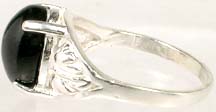
However for most, the unique nature and character of these antique gemstones more than makes up for the blemishes found within the gemstones, as well as the cutting and finishing irregularities common to handcrafted gemstones, all of which are by and large are only visible under magnification. The setting is of contemporary origin. It is a high quality setting manufactured by one of the USA’s leading semi-custom mount producers. It is constructed of solid sterling silver. We do have the ability to have the ring sent out for resizing if requested. There as many other ring styles available, if you would like to see them, just contact us, we would be happy to share them with you. Most other setting styles in sterling silver are available at no additional cost. Additionally, if preferred, this mounting (as well as a wide variety of ring settings in other appealing styles) are also available in 14kt solid gold.
TOURMALINE HISTORY: Tourmaline's name comes from the Dutch traders who purchased gemstones from the Celanese (i.e., Ceylon or Sri Lanka). The word "turmali," meant "mixed", and the bright rainbow collections of gemstone varieties which the Dutch purchased were called "turmali" parcels. Tourmaline has been used as gem material for more than 2,000 years. Since tourmaline occurred in many of the ancient mines that yielded other precious stones, tourmaline was most likely known by the ancient Romans, but called other names such as emerald or topaz. In fact, through the sixteenth or seventeenth century, red and pink tourmaline were thought to be ruby.
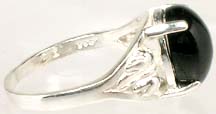
However one accurate reference to tourmaline in ancient history was by Theophrastus of Ancient Greece (student and successor of Plato and Aristotle) who in 314 B.C. accurately described tourmaline as becoming electromagnetically charged when it heated, noting that it would collect dust particles, straw and pieces of wood. In fact tourmaline can also become electromagnetically charged simply by rubbing it against one’s clothing, and the charge can remain for hours. There is also historical evidence which suggests that tourmaline was exported from Ceylon to ancient Israel as early as the time of King Solomon, and may have adorned the crown of the Queen of Sheba.
In the medieval world, alchemists believed tourmaline to be related to the philosopher’s stone, and as such could grant enlightenment, give power over spiritual affairs, reconcile opposites and change base metals to gold. Tourmaline was also used by medieval shamans who regarded it a “receptive stone,” which means it was soothing, calming, inward, and magnetic, and thus promoted meditation, spirituality, wisdom and mystical powers. During the Middle Ages tourmaline was also thought to heal physical and mental disorders as well as prevent death. Ancient mystical ceremonies in India included the use of the gem as a tool to bring insight and help in the discovery of that which is good, and to make known who or what was the cause of troubles or evil deeds. As well, various aboriginal tribes such as the American Indians, Australian Aborigines, and various African tribes, believed tourmaline to be a talisman which could protect against all dangers.

Tourmaline occurs in more colors and combinations of colors than any other gemstone variety. In fact an ancient legend says that tourmaline is found in all colors because it traveled along a rainbow and gathered all the rainbow's colors. Green or "chrome" tourmaline was "rediscovered" in the seventeenth century. This striking green gemstone is colored by the mineral chromium; hence the name "chrome" tourmaline. German miners in Brazil exported green tourmalines to bedazzled seventeenth century Europe, calling them "Brazilian emeralds". Within a few decades tourmaline was also rediscovered in the country of Tanzania on the African continent. In the eighteenth century, it was eventually realized that the "Brazilian emeralds" had unusual electromagnetic qualities, and were not emeralds at all.
Pink tourmaline was held in such high regard in Ancient China that Empress Tz'u Hsi, the last Empress of China, who loved pink tourmaline, bought almost a ton of it from the Himalaya Mine in California, and was eventually laid to rest (eternally) on a carved tourmaline pillow. In fact the Chinese have engraved and carved figures and snuff bottles from tourmaline for many centuries, and ancient examples are displayed in museums around the world. Many stones in the Russian Crown jewels from the 17th Century once thought to be rubies and emeralds are actually tourmalines. Chrome tourmalines are relatively uncommon gemstones, costly, and in scarce supply. They were considered the rarest variety of tourmaline until in 1989 very small quantities of even rarer Paraiba neon blue-green was discovered in Brazil, which sells for as much as $20,000 per carat. The most popular color is peach (or pink) tourmaline, and one of the most famous mines in the world, played out and closed in 1913, was in California.
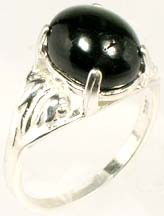
Throughout the history of the ancient world, gemstones were believed capable of curing illness, possessed of valuable metaphysical properties, and to provide protection. Found in Egypt dated 1500 B. C., the "Papyrus Ebers" offered one of most complete therapeutic manuscripts containing prescriptions using gemstones and minerals. Gemstones were not only valued for their medicinal and protective properties, but also for educational and spiritual enhancement. The ancient world regarded tourmaline helpful to artists, authors, actors and those in creative fields, enhancing their creative powers. Tourmaline was believed to possess many medicinal properties, including its ability to to cleanse, maintain, and stimulate the energy centers of the body.
It was also reported in an 18th century Dutch medical journal that tourmaline wrapped in silk and placed against the cheek of a feverish child would induce sleep. Tourmaline is still regarded as an aid for keeping the digestive system healthy as well as strengthening teeth and bones. It is also recommended for adrenal disorders, heart disease, arthritis, and used to treat stress and trauma. In regards to its metaphysical properties, tourmaline was believed to attract inspiration, to diminish fear, and encourage self confidence, enthusiasm, constructive thinking, and to assist the wearer avoid bad luck and negativity. It was regarded as conducive to promoting peaceful communication between the conscious and unconscious minds, allowing psychic awareness to blossom.
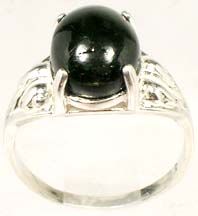
Tourmaline was regarded as a stone of reconciliation, a stone that fostered compassion and cool headedness, radiated the energy that attracted money, healing and friendship, and was used for “grounding” purposes, to stabilize, and reaffirm one’s “roots”. Pink tourmaline in particular was believed to be of great value to people that had difficulty dealing with fear, who had panic attacks or who were in need of something to help them heal their inner chaos and dread. It was regarded as a heart protector as well as an aphrodisiac, and was believed to provide reassurance that it was safe to love and therefore instilled confidence.
SHIPPING & RETURNS/REFUNDS: Your purchase will ordinarily be shipped within 48 hours of payment. We package as well as anyone in the business, with lots of protective padding and containers. All of our shipments are fully insured against loss, and our shipping rates include the cost of this coverage (through stamps.com, Shipsaver.com, the USPS, UPS, or Fed-Ex). International tracking is provided free by the USPS for certain countries, other countries are at additional cost. ADDITIONAL PURCHASES do receive a VERY LARGE discount, typically about $5 per item so as to reward you for the economies of combined shipping/insurance costs. We do offer U.S. Postal Service Priority Mail, Registered Mail, and Express Mail for both international and domestic shipments, as well United Parcel Service (UPS) and Federal Express (Fed-Ex). Please ask for a rate quotation. We will accept whatever payment method you are most comfortable with.
 Please note for international purchasers we will do everything we can to minimize your liability for VAT and/or duties. But we cannot assume any responsibility or liability for whatever taxes or duties may be levied on your purchase by the country of your residence. If you don’t like the tax and duty schemes your government imposes, please complain to them. We have no ability to influence or moderate your country’s tax/duty schemes. If upon receipt of the item you are disappointed for any reason whatever, I offer a no questions asked 30-day return policy. Send it back, I will give you a complete refund of the purchase price; 1) less our original shipping/insurance costs, 2) less any non-refundable eBay fees. Please note that eBay may not refund payment processing fees on returns beyond a 30-day purchase window. So except for shipping costs, we will refund all proceeds from the sale of a return item. Though they generally do, eBay may not always follow suit. Obviously we have no ability to influence, modify or waive eBay policies.
Please note for international purchasers we will do everything we can to minimize your liability for VAT and/or duties. But we cannot assume any responsibility or liability for whatever taxes or duties may be levied on your purchase by the country of your residence. If you don’t like the tax and duty schemes your government imposes, please complain to them. We have no ability to influence or moderate your country’s tax/duty schemes. If upon receipt of the item you are disappointed for any reason whatever, I offer a no questions asked 30-day return policy. Send it back, I will give you a complete refund of the purchase price; 1) less our original shipping/insurance costs, 2) less any non-refundable eBay fees. Please note that eBay may not refund payment processing fees on returns beyond a 30-day purchase window. So except for shipping costs, we will refund all proceeds from the sale of a return item. Though they generally do, eBay may not always follow suit. Obviously we have no ability to influence, modify or waive eBay policies.
ABOUT US: Prior to our retirement we used to travel to Eastern Europe and Central Asia several times a year seeking antique gemstones and jewelry from the globe’s most prolific gemstone producing and cutting centers. Most of the items we offer came from acquisitions we made in Eastern Europe, India, and from the Levant (Eastern Mediterranean/Near East) during these years from various institutions and dealers. Much of what we generate on Etsy, Amazon and Ebay goes to support worthy institutions in Europe and Asia connected with Anthropology and Archaeology. Though we have a collection of ancient coins numbering in the tens of thousands, our primary interests are ancient/antique jewelry and gemstones, a reflection of our academic backgrounds.
 Though perhaps difficult to find in the USA, in Eastern Europe and Central Asia antique gemstones are commonly dismounted from old, broken settings – the gold reused – the gemstones recut and reset. Before these gorgeous antique gemstones are recut, we try to acquire the best of them in their original, antique, hand-finished state – most of them originally crafted a century or more ago. We believe that the work created by these long-gone master artisans is worth protecting and preserving rather than destroying this heritage of antique gemstones by recutting the original work out of existence. That by preserving their work, in a sense, we are preserving their lives and the legacy they left for modern times. Far better to appreciate their craft than to destroy it with modern cutting.
Though perhaps difficult to find in the USA, in Eastern Europe and Central Asia antique gemstones are commonly dismounted from old, broken settings – the gold reused – the gemstones recut and reset. Before these gorgeous antique gemstones are recut, we try to acquire the best of them in their original, antique, hand-finished state – most of them originally crafted a century or more ago. We believe that the work created by these long-gone master artisans is worth protecting and preserving rather than destroying this heritage of antique gemstones by recutting the original work out of existence. That by preserving their work, in a sense, we are preserving their lives and the legacy they left for modern times. Far better to appreciate their craft than to destroy it with modern cutting.
Not everyone agrees – fully 95% or more of the antique gemstones which come into these marketplaces are recut, and the heritage of the past lost. But if you agree with us that the past is worth protecting, and that past lives and the produce of those lives still matters today, consider buying an antique, hand cut, natural gemstone rather than one of the mass-produced machine cut (often synthetic or “lab produced”) gemstones which dominate the market today. We can set most any antique gemstone you purchase from us in your choice of styles and metals ranging from rings to pendants to earrings and bracelets; in sterling silver, 14kt solid gold, and 14kt gold fill. When you purchase from us, you can count on quick shipping and careful, secure packaging. We would be happy to provide you with a certificate/guarantee of authenticity for any item you purchase from us. There is a $3 fee for mailing under separate cover. I will always respond to every inquiry whether via email or eBay message, so please feel free to write.

